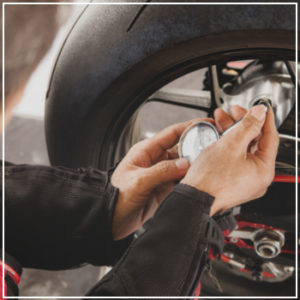
Motorcycle tires literally set the pace for your ride, in terms of handling and performance. When tires show significant signs of wear, your bike may feel drastically different, which could increase the chance you’ll lose control. Whether you perform motorcycle maintenance yourself or have a trusted mechanic, here’s what you should know about taking care of your bike’s tires.
Regularly Check the Pressure
Before taking a ride, use a tire gauge to check the front and back pressure, which is measured in pounds per square inch (PSI). If you’re unsure about the recommended PSI, check your owner’s manual.
It’s important to ensure both tires are properly inflated. Multiple factors can affect pressure, including how long you’ve been riding on the tires and current weather conditions.
If the pressure is low, you’ll need to pump both tires with compressed air to reach the desired PSI. If the tires are over-inflated – often a result of warmer weather or the load you’re carrying – bleed them via the Schrader valve.
As a note, some dealers use nitrogen instead of air, which makes the tires run cooler.
When you return home, give both tires a thorough once-over to check for nails or glass shards embedded in the rubber, cracked material, tread separation, bubbling or bulging. These factors not only affect tire pressure but also increase your risk of a blowout.
If you test the pressure after riding for a few hours and notice it has slightly increased, you may need to reduce your bike load or travel at slower speeds.
Check the Treads
Worn treads are a telltale sign your tires are on their last legs and will no longer effectively handle slippery or rough conditions. Get in the habit of checking your tire treads every time you go out for a ride.
First, look to see if the rubber has started to develop a smooth appearance. If the rubber and wear bars look one in the same, too much material has worn away. If the tire’s stitching is visible, there’s not enough material left to safely ride. You can also use a gauge to indicate how many millimeters are left.
Why are treads important? Motorcycle tires have direct contact with the road and, as you move, divert water away to reduce risk of hydroplaning. Without this functionality, your bike could lose traction.
How to Treat Your Tires
Not all rubber compounds are the same. Know the type of tire your motorcycle needs for optimal handling. Beyond this, riders should think about:
- Breaking In Tires: Riders are encouraged to travel carefully on new tires, as you break in the rubber and see how well the tires handle corners and different surfaces.
- Alignment and Balance: If your bike’s tires are misaligned and unbalanced, they may experience quicker wear, leading to a premature blowout. As a rule of thumb, check the balance every 500 to 1,000 miles.
- Never Flipping Tires: Although your car’s tires may be rotated, don’t be tempted to do the same with your motorcycle. It can prove detrimental to flip or reverse a tire that’s starting to show more wear on one side. If a tire is not traveling in the right direction, the material starts to come off, shortly followed by the treads.
- How You Change Tires: As a general rule, always use the same tires for the front and back – avoid two different brands or tire types. Never use car tires on your motorcycle, as the rubber, traction and contact patch are drastically different.
- Dealing with Nails: Whether you use a rope plug or patch kit to remove a nail from your tire, this should not be a permanent fix. Temporarily repair the tire, take it slow to the motorcycle shop and get a replacement as soon as possible.
What are your best tire maintenance tips for prolonged performance? Share them on our Facebook page.
